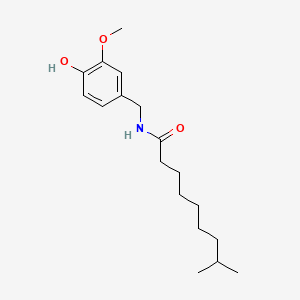| MeSH term | MeSH ID | Detail |
|---|---|---|
| Pain | D010146 | 64 associated lipids |
| Body Weight | D001835 | 333 associated lipids |
| Arthritis | D001168 | 41 associated lipids |
| Weight Gain | D015430 | 101 associated lipids |
| Tachycardia | D013610 | 7 associated lipids |
| Hypothermia | D007035 | 19 associated lipids |
| Out-of-Hospital Cardiac Arrest | D058687 | 1 associated lipids |
Capsaicin
Capsaicin is a lipid of Fatty Acyls (FA) class. Capsaicin is associated with abnormalities such as Morphologically altered structure. The involved functions are known as inhibitors, Regulation, metaplastic cell transformation, Biochemical Pathway and Uptake. Capsaicin often locates in Tissue fiber, Mucous Membrane, Nerve Endings, group Ia axon and Membrane. The associated genes with Capsaicin are TRPV1 gene, WT-1, MAP1LC3A gene, EIF2S3 gene and SLC33A1 gene. The related experimental models are Transgenic Model.
Cross Reference
Introduction
To understand associated biological information of Capsaicin, we collected biological information of abnormalities, associated pathways, cellular/molecular locations, biological functions, related genes/proteins, lipids and common seen animal/experimental models with organized paragraphs from literatures.
What diseases are associated with Capsaicin?
Capsaicin is suspected in Morphologically altered structure and other diseases in descending order of the highest number of associated sentences.
Related references are mostly published in these journals:
| Disease | Cross reference | Weighted score | Related literature |
|---|
Possible diseases from mapped MeSH terms on references
We collected disease MeSH terms mapped to the references associated with Capsaicin
PubChem Associated disorders and diseases
What pathways are associated with Capsaicin
Lipid pathways are not clear in current pathway databases. We organized associated pathways with Capsaicin through full-text articles, including metabolic pathways or pathways of biological mechanisms.
Related references are published most in these journals:
| Pathway name | Related literatures |
|---|
PubChem Biomolecular Interactions and Pathways
Link to PubChem Biomolecular Interactions and PathwaysWhat cellular locations are associated with Capsaicin?
Visualization in cellular structure
Associated locations are in red color. Not associated locations are in black.
Related references are published most in these journals:
- Am. J. Physiol. (1)
- Am. J. Physiol. Regul. Integr. Comp. Physiol. (1)
- Drug Metab. Dispos. (1)
- Others (1)
| Location | Cross reference | Weighted score | Related literatures |
|---|
What functions are associated with Capsaicin?
Related references are published most in these journals:
| Function | Cross reference | Weighted score | Related literatures |
|---|
What lipids are associated with Capsaicin?
There are no associated biomedical information in the current reference collection.
What genes are associated with Capsaicin?
Related references are published most in these journals:
- Am. J. Physiol. Regul. Integr. Comp. Physiol. (2)
- Am. J. Physiol. (1)
- Drug Metab. Dispos. (1)
- Others (1)
| Gene | Cross reference | Weighted score | Related literatures |
|---|
What common seen animal models are associated with Capsaicin?
Transgenic Model
Transgenic Model are used in the study 'In vitro hepatic and skin metabolism of capsaicin.' (Chanda S et al., 2008).
Related references are published most in these journals:
| Model | Cross reference | Weighted score | Related literatures |
|---|
NCBI Entrez Crosslinks
All references with Capsaicin
Download all related citations| Authors | Title | Published | Journal | PubMed Link |
|---|---|---|---|---|
| Pigatto GR et al. | Light-Emitting Diode Phototherapy Reduces Nocifensive Behavior Induced by Thermal and Chemical Noxious Stimuli in Mice: Evidence for the Involvement of Capsaicin-Sensitive Central Afferent Fibers. | 2017 | Mol. Neurobiol. | pmid:27056078 |
| Schepetkin IA et al. | Modulation of Human Neutrophil Responses by the Essential Oils from Ferula akitschkensis and Their Constituents. | 2016 | J. Agric. Food Chem. | pmid:27586050 |
| Scholl A et al. | Inhibition of interleukin-1β-induced endothelial tissue factor expression by the synthetic cannabinoid WIN 55,212-2. | 2016 | Oncotarget | pmid:27556861 |
| Belvisi MG et al. | Neurophenotypes in Airway Diseases. Insights from Translational Cough Studies. | 2016 | Am. J. Respir. Crit. Care Med. | pmid:26741046 |
| Malty RH et al. | Long-term exposure to PGE2 causes homologous desensitization of receptor-mediated activation of protein kinase A. | 2016 | J Neuroinflammation | pmid:27400965 |
| Pittman SK et al. | Nerve growth factor alters microtubule targeting agent-induced neurotransmitter release but not MTA-induced neurite retraction in sensory neurons. | 2016 | Exp. Neurol. | pmid:26883566 |
| Åžavk E | Neurologic Itch Management. | 2016 | Curr. Probl. Dermatol. | pmid:27578080 |
| Amantini C et al. | Capsaicin triggers autophagic cell survival which drives epithelial mesenchymal transition and chemoresistance in bladder cancer cells in an Hedgehog-dependent manner. | 2016 | Oncotarget | pmid:27367032 |
| Petrosino S et al. | The anti-inflammatory mediator palmitoylethanolamide enhances the levels of 2-arachidonoyl-glycerol and potentiates its actions at TRPV1 cation channels. | 2016 | Br. J. Pharmacol. | pmid:25598150 |
| Wandji BA et al. | Antinociceptive effects of the aqueous and methanol extracts of the leaves of Pittosporum mannii Hook. F. (Pittosporaceae) in mice. | 2016 | J Ethnopharmacol | pmid:27130641 |
